Search our Archives:
» Home
» History
» Holidays
» Humor
» Places
» Thought
» Opinion & Society
» Writings
» Customs
» Misc.
|
Jews and Latter Day Saints
By Jerry Klinger
“Latter-day
Saints believe themselves to be either direct descendants of the
House
of Israel,
or adopted into it. As such, Judaism is foundational to the history
of Mormonism; Jews are looked upon as a Covenant people of God, held
in high esteem, and are respected in the Mormon faith system. The LDS
church is consequently very Philo-Semitic
in
its doctrine”.
~~~~~~~~~~~~~~~~~~~~~~~~~~~~~~~~~~~~
September
22, 1827, in upstate New York near Palmyra, Joseph Smith Jr. a young
farmer of modest background lived, when according to Mormon belief,
he was visited by the Angel Moroni. After four years of intense
spiritual preparation, the Angel permitted him to take possession of
a long ago buried book inscribed on golden tablets. The book
revealed God’s dealings with the ancient Israelite inhabitants
of the Americas. In addition to the book, the Angel permitted Smith
to take possession of the breastplate that the High Priest in the
Temple of Solomon had worn, the Urim and Thummim.
Smith
carried the book’s message to the people of his community and
quickly drew believers. He also drew acrimony and made dangerous
enemies. Seeking a safe place to live and continue his revealed
ministry, Smith relocated time and time again, with his growing
community. Near Nauvoo, Illinois on the banks of the broad, muddy
Mississippi River he was murdered, June, 1844. He rests, with family
members in a quiet dignified simple setting on the river’s
shore. The golden plates, the Urim and the Thummim long had
disappeared – stolen from Smith, never to be found again. Yet,
his church grew and prospered as did the intolerance and hatred of
its adherents.
The
hostility to the Mormon community by the surrounding Christian
communities was deathly real.
Brigham
Young emerged as Smith’s successor. He announced to the Church
members (1846) there was a promised land. There was a land far to
the West, across the great American Desert, as the Great Plains were
known. It was a land where they could worship God as they believed
right and as God guided. He would lead them to their new home.
Brigham Young, called by some the American Moses, led his flock in
Mormon imagery, in a great Exodus, across the desert to the Promised
Land in the American Wilderness. It would be a home near the
American Dead Sea, the Great Salt Lake, surrounded by high snow
capped mountains that reached to God. They called the land Utah from
the indigenous Ute
tribe of Native Americans, meaning “people of the mountains”
Brigham
Young and most Mormons believe themselves descended from or converted
members of the ancient Israelite lost tribe of Ephraim. It was if
they were the first Jews coming to Utah.
The
first Jew to see the Great Salt Lake and climb the great Utah
mountain barriers of the Rockies was said to be an unnamed Jewish
mountaineer. He hunted for furs with Jim Bridger, a mountaineering
legend, during the 1820’s through the 1840’. Indian
stories are replete with references to the “egg eaters.”
Mountain Men and later itinerant traders who would not eat meat but
carried with them hard boiled eggs. They would eat only the eggs,
fruit, nuts, and vegetables.
Jews
have been noted, many times, as members of wagon trains that crossed
Utah on their way to California and Oregon, but they did not stop to
settle.
As
the American frontier pushed West, Jews were part of it. One of the
greatest Western explorers was John C. Fremont; a man nicknamed the
"Pathfinder." On a number of his missions of exploration he
was joined by F.W. Von Eggelstein his Jewish cartographer and Solomon
Nunes Carvallo, the great Jewish American painter from South
Carolina, who captured the West for posterity on canvas. Caught in a
terrible winter blizzard in southern Utah, Carvallo came near death
due to starvation and exposure. A Mormon family from Parowan, Utah
rescued him and nursed him back to health, Feb., 1854.
Needing
funding, Carvallo set up a portrait studio in Salt Lake City.
Brigham Young had graciously welcomed him. Carvallo painted the
famed portraits of Brigham Young, various church leaders and sketched
Chief Walker. Continuing west to Los Angeles, he met with other Jews
there before returning east. In 1857 he published Incidents
of Travel and Adventure in the West.
Owing to the paucity of record keeping by John Fremont, Carvallo’s
diaries of the disastrous Freemont 1853-1854 mission of exploration,
Carvallo’s book and sketches became the definitive historical
records that are used by scholars of the American west today.
The
first permanent Jewish settlers in Utah were a young Jewish couple
from Silesia, recent immigrants to America, Julius Gerson Brooks and
his wife Isabell (Fanny). Julius, born in 1821, immigrated to New
York when he was twenty one. He made his living as a peddler through
New England making a modest living. Returning to Silesia he married
sixteen year old Fanny and the young couple returned to America.
They
moved west to, Galena, Illinois to try their luck. A recently
returned army veteran from the Far West told them of fascinating
opportunities if they will but reach for it. Joining a wagon train
of fifteen Calistoga Wagons, Prairie
Schooners,
they headed toward Oregon by way of Utah. July of 1854 they reached
the Salt Lake Valley. The beauty and possibilities stirred them.
They quickly decided to make Salt Lake City their home. The
Millennial Star, the local newspaper in 1854, listed twenty two
businesses. Included was the “Mrs. Brooks’ Millinery
Store and Bakery.” The Brooks’ were to become solid
citizens of Salt Lake City and Utah; respected members of the
business, religious and social community. Builders of the Brooks
Arcade, their name was and is still recognized. In time the Brooks
opened shops in the gold mining communities of Marysville, California
and various Sierra Nevada mining towns. The Brooks prospered in
Utah. The Brooks prospered in America.
In
later years, Julius Brooks told his daughter, Mrs. Samuel H.
Auerbach, that the returned army veteran, who had told them of the
many opportunities in Galena, Illinois so many years ago, tried his
hand at farming. He failed as a farmer in Illinois. He later tried
his abilities as a merchant in Galena. He failed at that as well.
His name was Ulysses S. Grant. Grant succeeded as a Union Civil War
general and became the President of the United States.
Brigham
Young and Mormon hopes of setting up a separatist, theologically
based home in Utah quickly ran into conflict with the Federal
Government of the United States. The Federal government claimed
ultimate sovereignty. 1857, President Buchanan sent Federal troops
under Col. Albert Sidney Johnston
to Utah. Brigham Young sounded the alarm. Mormon men assembled for
military duty to defend their New Zion against the “Gentiles.”
Non Mormons as well as Jews were known as Gentiles. The “Utah
War” broke out. Mormon settlements were abandoned, Salt Lake
City was evacuated. Col. Johnston rode into Utah, nary a shot was
fired in anger. The war, ofrnon- war was over in a bloodless victory
for the Union.
Wanting
to avoid conflict with the returning, uneasy Mormons, Johnston set up
Camp Floyd, a military camp thirty five miles from Salt Lake City.
Not wishing to be caught in the potential fighting between Mormon and
Gentile, the Brooks’ moved for a ten year period to
California. The only Jews
remaining in Utah in 1857, at the time of the war, were two
documented Jews who had converted to Mormonism. Alexander Neibaur
arrived in Utah in 1848. He was said to have been educated as Rabbi.
Levi Abrahams, the second Jewish convert, arrived in 1854.
The
establishment of Camp Floyd brought much needed hard currency and
significantly increased economic activity in the Salt Lake economy.
The Pony Express and the Overland Stage service were introduced. The
needs of the soldiers and their families encouraged the movement of
non-Mormon settlers, wagoners, freighters and shopkeepers to move
into the valley. Jewish merchants and freighters arrived with the
rising economic opportunities.
Nicholas Siegfried
Ransohoff, a German Jew, arrived in 1858. He helped organize Utah’s
first Masonic Lodge. Contemporary records observed Ransohoff
peculiar dietary restrictions. Camp Floyd was closed by President
Lincoln two years later. Every soldier was needed back east to serve
in the Union army. All the garrison supplies had to be sold.
Ronsohoff, as did other non-Jewish merchants, bought supplies on the
spot for cash. However, Ransohoff could not take delivery of a large
supply of salted, stored meat. The meat was pork and his Orthodox
observances, even on the frontier, did not permit him to deal in
pork. Ransohoff instead advanced Brigham Young $30,000 to purchase
the entire supply of pork. Ransohoff and young remained close friends
for the balance of their lives.
Samuel
H. Auerbach, representing his brothers Frederick and Theodore, Jewish
merchants from California, arrived in 1859 with a wagonload of goods.
The Auerbachs expanded from one rugged gold rush mining town after
another, from Rabbit Creek to Bodie, California. Mining boom towns
were not for the faint hearted. Bodie’s reputation was anchored
forever when a young girl wrote in her diary, “Goodbye God, I’m
going to Bodie.” Auerbach opened up a tent store in Salt Lake
City to business. Only this time, he and his brother Frederick chose
to stay when the army moved away to fight in the War
Between the States.
F.
Auerbach & Brothers flourished in Utah, becoming significant
factors in its economic development. When the Union Pacific Railroad
stretched across America from the east, in the great race to build a
transcontinental rail line with the Central Pacific coming from the
west, the Aurbach’s set up stores as the line advanced, from
Bryan, Wyoming to Ogden. At Promontory Point, two spikes, one gold,
one silver, were driven anchoring the last rail in place. The spikes
united the American continent into a single unified country. F.
Auerbach & Brothers were there to witness the moment in history.
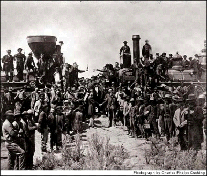
Driving the Spikes -1869
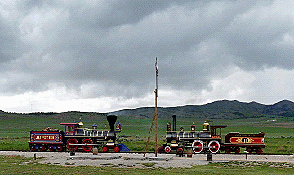
Promontory Point
Tensions
between the Mormons and the Gentiles
continued
to grow during and after the Civil War.
Mormons
accused the Gentile merchants of profiteering and immoral economic
activity culminating in charges of Federal Judicial corruption and
murder. Mormon Church leaders began preaching against the outsiders.
A boycott of non-Mormon businesses was initiated. Mormons actively
responded to the boycott call. One year after the end of the Civil
War, 1866, the Gentile merchants were facing ruin. They organized
themselves and wrote to Brigham Young offering to be bought out.
Young,
ever mindful of Federal governmental interference in New Zion’s
life, was concerned. Forcing out non-Mormons would invite even
heavier Federal interference in Utah. The Church’s response,
create a business moral compass, a parallel mercantile arrangement.
Prices that the Church deemed fair would be charged in a Mormon led
and approved businesses. The Gentiles would have to compete against
the newly created Zion’s Cooperative Mercantile Institution.
Signboards appeared above Mormon businesses, an “all-seeing
eye” identifying them as being members of the ZCMI were painted
at the top. Sales at Gentile and Jewish stores alike collapsed. The
competitive boycott by the Mormons took hold. Many Gentile and
Jewish businesses failed or moved north toward the railhead robust
Gentile town of Corinne.
Corinne served the
mining towns of Montana and Wyoming. In 1873, Corinne, swollen to
4,000 souls, was booming. Over time the boycott eased. Jewish and
Gentile businesses were forced from Salt Lake City. The damage to
Salt Lake’s economy, the societal positive of the Church,
injured the Mormons as well. Twenty years later Corinne was a ghost
town, the boycott, long over. Jewish and Gentile Merchants moved back
to Salt Lake City. The Corinne and ZCMI accomplishment had produced
a growing political awareness amongst the Gentiles of the need to
create a political counter-balance to Mormon dominance. Utah’s
first opposition party emerged in the hamlet of Bear River. Largely
led by Christians, the nascent political effort included Jewish names
in its roles, Samuel Kahn, Gumpert Goldberg, Julius Malsh and Simon
Bamberger.
The
seemingly lost decades of 1860-1880 did not mean that the Jews were
forced from their homes in Salt Lake City. Jews have always had a
special relationship with the Latter
Day Saints.
Jews were viewed much more favorable than were Christians by the
Saints.
“They were distant cousins”. The small Jewish community
in Salt Lake City continued to grow.
The
small Jewish community in Salt Lake City formed the Hebrew Benevolent
Society in 1864. The Society looked after Jews who were poor or had
fallen on hard times. High Holiday services were held in the homes
of a local Jewish merchants between 1864 and 1866. Later, the Mormons
generously donated use of the Seventies Hall, an LDS communal
building accommodating the growing Jewish community’s need for
more space for High Holiday services. They wanted to encourage the
Jews to worship God. Brigham Young, respecting and supporting the
Jewish community’s needs, donated land to the Jews, 1869, for
a communal Jewish cemetery.
In
succeeding years, Jewish worship was held in LDS buildings, Masonic,
Odd Fellows and other rented space. The Jewish community continued
to grow. Itinerant mohels, such as Rabbi H. Lovenberg of Elko,
Nevada, came to Salt Lake to circumcise Jewish children. A Torah was
obtained. The need for a Jewish communal center was becoming
evident.
Congregation
B’nai Israel (Children of Israel) was formally organized in
1873. Five years later, the Congregation began talking seriously
about a permanent Jewish house of worship and a religious school to
educate their children.
July
9, 1881, twenty three members of B’Nai Israel met and
authorized, President Henry Siegel to purchase a lot at First West
and Third South Streets in Salt Lake.
Siegel signed the papers and paid John Sharp $2,600 for the
“Tanner’s lot”. Construction of the synagogue was
completed in 1883. It was an strange sight for Gentile and Mormon
alike in Salt Lake, a Jewish ceremonial parade, chupah, singing and
rejoicing as the Torah was proudly carried to the new synagogue. The
first service, at the first permanent Jewish house of worship in Utah
was held March, 1883.
Keeping
kosher was considered near impossible in Salt Lake City where no
shochet and no Rabbi were employed. Holidays were celebrated from
fasting on Yom Kippur with a full day of prayer to matzas on Pesach
as traditionally as possible. The Torah was read every Shabbat.
After a year of effort, discomfort grew within the congregation. The
largely German Jewish membership felt increasingly separated from the
developing American Jewish tradition they wished to follow.
Congregation B’Nai Israel voted to invite to their pulpit a
young, recent graduate from the reform Hebrew Union College in
Cincinnati, Rabbi Leon Strauss. Rabbi Strauss brought with him the
Minhag America, a new siddur. The siddur was a product of Rabbi
Isaac Mayer Wise’s
reformation of the European Orthodox model of worship. The Minhag
America siddur reflected Wise’s understanding of the American
Jewish community’s needs. Reform services incorporated English
sermons, men and women sitting together, not wearing a kippah,
sometimes organ music and in some places changing the Sabbath day to
Sunday. Conforming more and more to the Christian environment about
them Jews were able to assimilate better. Ultimately changes in the
traditional interpretation of Jewish religious law, especially what
was Kosher or not, and Jewish concepts of salvation were included to
more closely reflect American life. When Rabbi Strauss arrived in
1884, Reform Judaism was the overwhelming choice of worship that
American Jewry adapted.
Rabbi
Strauss, the first Rabbi in the State of Utah, served only ten months
before the congregation broke apart, acrimoniously, bitterly over the
form of the 1885 High Holiday services he had proposed. Orthodox
members of the Congregation B’Nai Israel angrily left to hold
services once again in private homes. The majority of Congregation
B’Nai Israel, wishing a Reform High Holiday worship of God,
rented space separately. The first Jewish house of worship fell into
discordant disuse and decayed. The building, used by neither the
Orthodox nor the Reform, was sold June 16, 1889 for $20,000.
The
need and desire for a permanent house of worship remained. The
Reform majority set out immediately to raise funds, purchase land and
contract to build a new bigger, more impressive Temple. Their new
Temple would be a statement, to the Mormon and the Christian
communities about them, of Jewish presence, affluence, acceptance and
permanence in Utah.
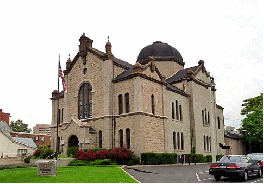
Congregation B’nai Israel
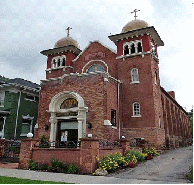
Congregation
Montefiore
The
Reform Community fully reconstituted as Congregation B’Nai
Israel purchased a lot at 249 South 400 East Streets in Salt Lake
City. A magnificent Temple, rock faced native Kyune stone building
with a huge golden dome rising 83 feet from the ground, was built by
the 83 family membership. Phillip Meyer, the nephew of Frederick H.
Auerbach of Salt Lake was brought in to design the structure. Meyer,
the German government architect for the Kaiser, created a design that
was a smaller reproduction of the Great Synagogue in Berlin, Germany.
Phillip Meyer was murdered by the Nazis, Oct.
15, 1943 at the German concentration camp of Theresienstadt.
Berlin’s Great Synagogue was burned on Kristallnacht. Meyer’s
parents, Gustav Meyer and Rosa Auerbach Meyer, lived in Salt Lake
City. They are buried in the Salt Lake City Jewish cemetery.
The cornerstone of
the new temple was laid Sept. 26, 1890. The building was dedicated
July 12, 1891.
The 1880’s
began the huge displacement of millions of Eastern European and
Russian Jews to America. Some migrated to Salt Lake City and Utah.
The small Orthodox
former members of Congregation B’Nai Israel renamed
their community, “Congregation Montefiore, in honor of the
great English Jew, Sir Moses Montefiore. In 1902, Morris Levy donated
a lot at 355 South Third East and Isadore Morris placed $150 in gold
dust on the table to begin contributions toward building a new
synagogue. The cornerstone was laid on 13 August 1903, with a
dedicatory address by President Joseph F. Smith of the LDS Church. A
large contribution by the LDS Church was probably acknowledged by
this honor.
The
dissension concerning ritual continued within Congregation
Montefiore. The Conservative ritual seemed inappropriate to several
of the more Orthodox members. Accordingly, a third congregation was
established under the name of Shaarey Tzedek (Gates of Righteousness)
in 1918. This new congregation built a synagogue at 833 South Second
East. The financial woes of the Great Depression ended Shaarey Tzedek
in 1932, and its members found their way back to Congregation
Montefiore. However, the three congregations had separate
cemeteries--Bnai Israel and Montefiore within City Cemetery above
Fourth Avenue and Shaarey Tzedek above Twelfth Avenue.”
Congregation
Shaarey Tzedek closed its doors due to a lack of membership growth
and a lack of funds.
Congregation
Montefiore merged with Congregation B’nai Israel in 1972, after
many years of debate and discussion.
A new combined congregation was established, Congregation Kol Ami.
A new building was built.
The new congregation prides itself, as Louis Zucker reflected at the
time, “As Jews, we are free to the utmost, in this Mormon Zion,
to shape our ends and means as a community and congregation as we
ourselves desire.”
Congregation Kol Ami describes itself, “We do our best to
serve every Jew in our midst. We belong to both the Union for Reform
Judaism and the United Synagogue of Conservative Judaism.”
They have 385 member families.
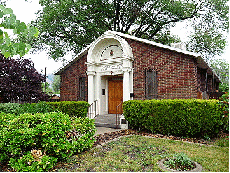
Congregation B’rith
Shalom, Odgen, Utah
Salt
Lake City was not the only city in Utah to organize and build a
Jewish house of worship. Ogden, Utah, about 40 miles north of Salt
Lake City, not far from the former Gentile city of Corinne, was built
as a rail head for the Union Pacific Railroad. As a commercial center
it too attracted Jewish merchants looking for economic opportunity.
The Jewish community of Ogden organized themselves into an Orthodox
congregation, Ohav Shalom in 1890. Ogden’s streets are named
for the U.S. Presidents. The synagogue is located on Grant Ave.
Ohav
Shalom, as did Ogden, remained relatively small. The community grew
slowly. Ohav shalom changed its name, 1921, to Brith Shalom and
built a small permanent synagogue building. The community is a
member of the American Reform movement today. Fire In the 1990’s
severely damaged the interior of the the synagogue. Congregation
Brith Shalom is of modest means. They generally have a Rabbi on an
itinerant basis and or on High Holidays. Weekly services are
conducted by the membership. To rebuild the synagogue and to recover
from the terrible fire, the larger Christian and Mormon communities
contributed labor, money and love. Ogden is recognized today, by
most Americans, as the location of the Internal Revue filing center.
Utah’s
Jewish history is unique in two other aspects. The first non-Mormon
to be elected Utah’s governor was a Jew. “In 1916,
Simon Bamberger ran for the office of governor of the state of Utah.
Bamberger was the first non-Mormon, the first Democrat and the only
Jew ever to seek that office. During the campaign, Bamberger visited
a remote community in Southern Utah that had been settled by
immigrant Norwegian converts to Mormonism. According to historian
Leon Watters, the community’s leader, a towering Norwegian, met
Bamberger at the train and told him menacingly, "You might yust
as vell go right back vere you come from. If you tink ve let any damn
Yentile speak in our meeting house, yure mistaken." Bamberger is
said to have replied, "As a Jew, I have been called many a bad
name, but this is first time in my life I have been called a damned
Gentile!" The Norwegian threw his arm around Bamberger and
proclaimed, "You a Yew, an Israelite. Hear him men, he’s
not a Yentile, he’s a Yew, an Israelite. Velcome my friend;
velcome, our next governor." The Norwegian was correct;
Bamberger won the election.
His
Mormon friends noted Bamberger’s civic mindedness and urged him
to run for governor. Despite being a Democrat, Bamberger’s
policies paralleled those of Teddy Roosevelt and the Progressives. He
insisted that the legislature balance the state budget, create a
public utilities commission to regulate the price of electricity and
gas and banned gifts by utility companies to public officials. He
passed a modified line-item budget veto; created a state department
of public health; instituted water conservation; and advocated for a
lengthened school year, workers’ compensation, the rights of
unions and the non-partisan election of judges. Bamberger, a
teetotaler, supported prohibition. He saw most of his platform voted
into law.
Bamberger died in 1926 and is
buried in the cemetery of Congregation B’nai Israel, Salt Lake
City.
Of course,
he’s buried in the ‘Yentile’ section.”
Bamberger strongly supported,
1910, a Jewish agricultural settlement in Clarion, Utah. Theodor
Herzl had died six years earlier. Herzl began a vast movement of
Jews in spirit if not in fact to return to Palestine to rebuild Zion.
Agriculture was a central part of Zionism. Bamberger wanted Jews to
come to the New Zion.
The idea
of Jews becoming farmers was not new to the American Jewish
experience. It had been tried repeatedly for the previous thirty
years, almost always ending in failure. The Jewish agricultural
community of Clarion survived for a few years only to end in failure.
Nothing is left of Clarion save a few Jewish graves. The graves of
the builders of the new Zion are respectfully tended to by the
present land owner, a Mormon.
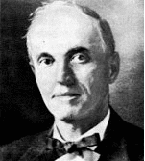
Moses Alexander
Simon Bamberger was not the first
Jewish American to be elected the governor of a U.S. State. Moses
Alexander was elected governor of Idaho, 1914. He served from
1915-1919. For a short few years two Jews served as governors of
American States, at the same time, Idaho and Utah.
Jews were not first elected to
governorships in the Eastern States where large concentrations of
Jews lived but in the frontier states of West. Freedom, toleration
and acceptance flowed from the West to the East. The American dynamic
of measuring an individual on the basis of who they were, what they
accomplished and not what religion they practiced was stronger in the
West than the East.
The history of Jewish relations
with the Latter Day Saints is a history as long as the church itself.
It is only in recent years that the Mormon theistic driven mission
to convert the living and the dead has brought the LDS church into
conflict with the Jewish world.
Joseph
Smith sent Orson Hyde,
an LDS apostle, to prepare the land of Palestine for the return of
the Jews to their ancient homeland. In Europe, Hyde sought meetings
with Jewish community leaders, not to proselytize them but to urge
them to return to Palestine. He continued on to Jerusalem. October
24, 1841, he prayed on the Mount of Olives to “dedicate and
consecrate this land… for the gathering together of Judah’s
scattered remnants.”
Orson Hyde’s mission began a long and continual positive link
between Mormonism, Palestine and later the modern State of Israel.
Senator William King of Utah
served from 1917-1941 in the U.S. House of Representatives and in the
United States Senate. Senator King was very instrumental in the
creation of the American Palestine Committee in the early 1920’s.
The American Palestine Committee’s purpose was to support the
Zionist movement’s objectives and the return of the Jews to
Palestine. The committee was a major national organization of
Christian leaders from the U.S. Congress, business, economic,
education and American religious movements. The American Palestine
Committee dissolved with the creation of the State of Israel.
Latter
Day Saints Church President Spencer W. Kimball dedicated
a 5
acre
park, overlooking the Old
City
near Mt. Scopus, in honor of Orson Hyde, October 24, 1979. It had
been 138 years to the day since Orson Hyde first came to the same
location, erected a small altar and offered his prayer beseeching
Gods blessings and to prepare the land for the return of the Jews. It
was Christian Zionist prayer., It was a Mormon Zionist prayer.
Teddy Kollek, mayor
of Jerusalem and other dignitaries, attended the park’s
dedication. President Kimball announced shortly after the
dedication plans to construct a permanent branch of the Brigham Young
University in Jerusalem. The church obtained a 49-year lease on land
and began construction in 1984. Leasing of land as opposed to
ownership of a land in Jerusalem was a political compromise to
satisfy the strong protests of the Jewish ultra Orthodox against the
Mormons. Until a 1982 agreement with Israel, the Mormons had been
aggressively seeking converts to Mormonism in Israel. After 1982,
the Mormon Church agreed to cease conversion activity amongst Jews in
Israel. The University opened to students in 1986. In Israel, the
Church observes Saturday as the Sabbath instead of Sunday.
The Church
of Jesus Christ of Latter-day Saints maintains the largest
genealogical database in the world. People often use it to trace
their roots, but the information is kept for religious reasons. The
goal of the church is to give every person who lived on Earth the
chance to accept the gospel. This can be accomplished only if the
ancestry of all humanity is traced back to Adam and Eve.
Mormon theology gives people the
chance to accept the gospel even after they die, reuniting families
in the afterlife. Many critics see the practice as changing the
deceased's faith involuntarily. Though the Mormons had agreed, in
writing, not to actively seek conversions of Jews in Israel it did
not preclude them from seeking to convert Jews that had died,
including in the Holocaust. The practice of converting the dead
Holocaust victims created a firestorm in Israel and amongst the world
Jewish community over the insensitivity of the Mormons. To Jews its
seemed to turn the victims of Holocaust into posthumous victims of
forced conversions. Resentment and anger at the Mormon practice
resulted in an agreement with the Mormons to cease posthumous
conversion of Holocaust victims. Because conversion of the deceased
is a fundamental tenet of Mormon faith, as late as 2008, Mormons have
again been accused of not honoring the 1995 agreement to cease
conversions of Jewish Holocaust victims.
The Mormon
community believes their efforts to flag Holocaust victims and their
families, to avoid including them in their genealogical records for
possible conversion, has been compliant and positive. The
disagreements between Mormon and the Jewish world continue. The
strain is real.
American Jewish life, since the
first Jewish refugees came ashore in New Amsterdam in 1654, has been
confounded with the willingness of America to more readily accept
Jews if they would give up the outward trappings of their “peculiar”
cultural identity. If Jews would be willing to shave their
side-locks, abandon their skull caps and become in form and worship
more “American,” the promise of America, the promise of
economic, social and political equality would be open to them. It has
largely been true. Most Jews chose to be more American, accepting the
golden ring offered to them, assimilating more and more.
Mormon’s
rejected abandonment of their differences, choosing instead to
maintain their own tight identity against the Gentiles. They choose
to abandon their homes among the Gentiles and seek a new Zion in the
West. They choose to be different. The Mormons have and are growing
rapidly. They began as an American religion. They are now a world
faith. Jews and Judaism, especially American Judaism, searching for
ways to become more like the rest of America and, not be so
different, is stagnant. Perhaps Jews have a lesson to learn from
the Mormons about the pride, the beauty and the future of being
different, believing in who you are.
* * * * *
Jerry Klinger is president of the
Jewish American Society for Historic Preservation.
www.JASHP.org
~~~~~~~
from the August 2009 Edition of the Jewish Magazine
|
|
Please let us know if you see something unsavory on the Google Ads and we will have them removed. Email us with the offensive URL (www.something.com)
|





|